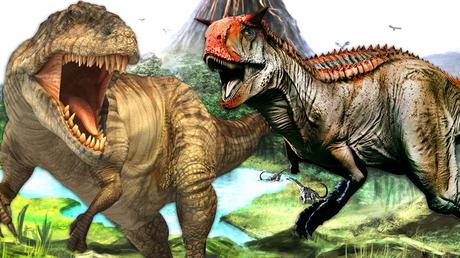
Dinosaurs roamed the planet for about 165 million years, during a time in the Earth's history called the Mesozoic Era. It is difficult to imagine how long this was, until we compare it with ourselves: humans have lived on Earth for less than two million years. During the Mesozoic Era, the Earth's landmasses changed dramatically, new seas were formed, and plants and animals evolved. In the middle of the 19th century, the first fossil skeletons of some extraordinary creatures were unearthed. These skeletons are of the dinosaurs - prehistoric reptiles that have captured the imaginations of people ever since. Dinosaurs, which means "terrible lizards", ruled the world for more than 160 million years before they died out 65 million years ago. Everything we know about them has come from the examination of skeletons, or bits of skeletons, found by paleontologists, the dinosaur-hunters of the modern world, and by other scientists.The development of feathers turned dinosaurs that could run or climb into birds that could fly. The earliest true bird is Archaeopteryx, which lived during the late Jurassic in the area known today as southern Germany. A small hunting dinosaur called Compsognathus also lived in that area at that time. Archaeopteryx looked like a cross between a reptile and a bird, and it had strong legs and feathers that it would have used to fly. Compsognathus was bird-like, with long back legs and hollow bones. Archaeopteryx had wings, with flying feathers arranged just like those of a modern bird, and its body was covered in feathers. However, it had the head, clawed hands, and long, bony tail of a dinosaur. It lived on tropical desert islands and walked and fluttered after its flying insect prey. It could not have flown very far or very fast as it did not have strong flight muscles. We know of literally thousands of non-avian dinosaur footprints scattered around the globe, from Late Triassic to Late Cretaceous age. You might not think that a footprint or a sequence of footprints (called a trackway) could tell us much, but actually it can tell us some general things about the biology of dinosaurs. Dinosaurs, living and extinct, have varied diets. We have some strong evidence of exactly what the diets of some of the extinct dinosaurs was, and we can observe birds directly to learn about their diets. Dentition (tooth structure) is one of the most abundant lines of evidence useful for determining dinosaur diets. Most ornithischian and sauropodomorph dinosaurs had rather simple, short stubby crenellated teeth, which are similar to those of living herbivores, and clearly not too good for eating much meat. Stomach contents are another line of evidence, somewhat more direct but also a bit trickier to interpret accurately. Well-preserved dinosaur skeletons sometimes have traces of apparent food items preserved in their abdominal cavity, where it's safe to assume that they had a stomach. This includes pine cones and/or needles in some herbivores' guts, and traces of some vertebrates in some theropods' guts. So this independent line of inquiry substantiates the data from tooth morphology. Also, some sauropodomorph stomachs contain well- rounded stones, caled gastroliths, that were probably used to grind food in a muscular crop or gizzard, like some birds (and crocodilians) do. The general hypothesis that most ornithischians and sauropodomorphs were largely, if not completely herbivorous, and that theropods (at least before the origin of birds) were mostly carnivorous, thus holds. More specific hypotheses have been proposed and supported by data, while others have fallen by the wayside. It is likely that new discoveries will illuminate more about dinosaur diets as the global "dinosaur renaissance" continues.
Disclaimer: Journal Edge has made every effort to ensure the accuracy of the information contained in this Article. The Blog does not accept any legal responsibility for consequences that may arise from errors, omissions or any opinions given. This Article is not a substitute for specific professional advice on commercial or other matters.
